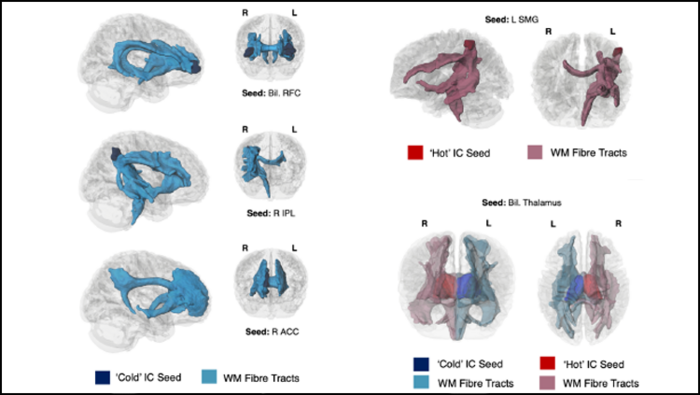As their brain regions linked to self-control mature, preschoolers improve in their ability to stop themselves from doing something, according to new research published in JNeurosci.

Credit: Berger et al., JNeurosci 2022
As their brain regions linked to self-control mature, preschoolers improve in their ability to stop themselves from doing something, according to new research published in JNeurosci.
A component of self-control called inhibitory control doesn’t develop until around age 4. In adolescence and adulthood, inhibitory control stems from a group of brain regions called the cognitive control network, but how the ability develops in young children is not well known.
Berger et al. examined the maturation of brain regions in 3- and 4-year-old children using MRI and compared it with their inhibitory control abilities. To test neutral inhibitory control, the researchers told the children to follow instructions from one sock puppet but ignore the instructions of another. To test emotional inhibitory control, the researchers placed candy in front of the children and told them if they did not eat it now, they would get more later.
The 4-year-olds performed better at both tasks than the 3-year-olds. Children with better inhibitory control had larger brain regions and stronger white matter connections in the cognitive control network. Each type of inhibitory control was tied to the maturation of distinct and separate regions in the network, indicating separate neural bases for different aspects of the development of inhibitory control.
###
Paper title: Maturational Indices of the Cognitive Control Network Are Associated With Inhibitory Control in Early Childhood
Please contact [email protected] for the full-text PDF and to join SfN’s journals media list.
About JNeurosci
JNeurosci, the Society for Neuroscience’s first journal, was launched in 1981 as a means to communicate the findings of the highest quality neuroscience research to the growing field. Today, the journal remains committed to publishing cutting-edge neuroscience that will have an immediate and lasting scientific impact, while responding to authors’ changing publishing needs, representing breadth of the field and diversity in authorship.
About The Society for Neuroscience
The Society for Neuroscience is the world’s largest organization of scientists and physicians devoted to understanding the brain and nervous system. The nonprofit organization, founded in 1969, now has nearly 37,000 members in more than 90 countries and over 130 chapters worldwide.
Journal
JNeurosci
DOI
10.1523/JNEUROSCI.2235-21.2022
Method of Research
Observational study
Subject of Research
People
Article Title
Maturational indices of the cognitive control network are associated with inhibitory control in early childhood
Article Publication Date
11-Jul-2022




